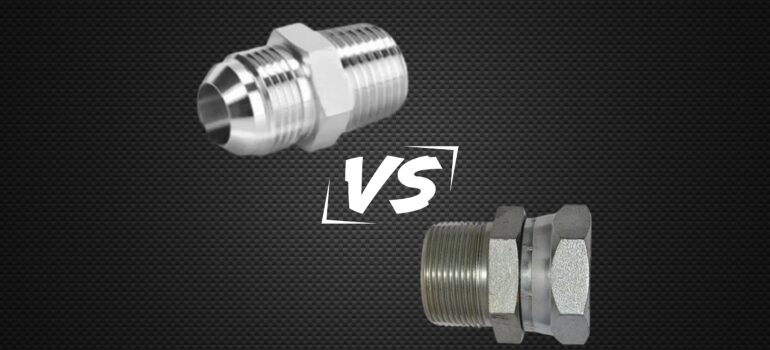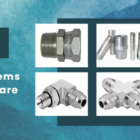Industrial Flare End Fittings: Optimizing Industrial Systems with Reliable Flare Fittings
Mcneil Instruments is a leading manufacturer, supplier, and exporter of Flare End Fittings, offering a wide range of products designed for industrial use. Our flare fittings are manufactured with precision to meet industry standards and are known for their durability, resistance to high pressure, and versatility in various applications. In this blog, we will explore what flare end fittings are, their types, applications, standards, and pressure ratings, providing a comprehensive overview for professionals seeking reliable solutions.
What Are Flare Fittings?
Flare fittings are a type of mechanical connection used to join metal tubing to various equipment or other metal tubing. These fittings are typically used to provide a leak-proof connection in systems where gases or fluids are transported. The end of the tube is flared at an angle (usually 45° or 37°) to create a secure seal when it meets the fitting.
- Leak-proof connections for fluid and gas systems
- Used in various high-pressure applications
- Flared at specific angles for a secure fit
Types of Flare Fittings Manufactured by Mcneil Instruments
Mcneil Instrument offers a wide range of flare end fittings, including:
- Swivel Adjustable Branch Tee: The Swivel Adjustable Branch Tee allows for fluid distribution through three outlets, with an adjustable angle for easy installation. It’s used in hydraulic and pneumatic systems where flexibility in direction is needed.
- Swivel Adjustable Elbow: The Swivel Adjustable Elbow connects two tubes at a 90-degree angle with an adjustable rotation feature. It’s ideal for applications requiring frequent adjustments or repositioning in confined spaces.
- Swivel Adjustable Run Tee: The Swivel Adjustable Run Tee provides three connection points, with the ability to adjust angles for easier routing. It’s commonly used in hydraulic systems that demand flexible, leak-free connections.
- Swivel Union: The Swivel Union offers a rotatable connection between two tubes, allowing for easy adjustments without compromising the seal. It’s designed for high-pressure applications where flexibility and secure fitting are critical.
- Swivel Pipe Adaptor: The Swivel Pipe Adaptor is used to connect different types or sizes of piping, featuring a rotating mechanism for easy installation. It ensures a reliable seal in both hydraulic and pneumatic systems.
- Collar: The Collar is a cylindrical fitting used to reinforce joints and improve sealing between tubes or pipes. It adds durability and support to various industrial applications, ensuring a tight and secure connection.
- Flare Male Connector: The Flare Male Connector connects a flared tube to a female threaded pipe, offering a strong, leak-proof connection. It’s commonly used in high-pressure fuel, gas, and refrigeration systems.
- Flare Female Connector: The Flare Female Connector is designed to join a flared tube to a male threaded pipe, providing a secure and durable seal. It’s widely used in hydraulic, pneumatic, and gas distribution systems.
- Flare Male Elbow: The Flare Male Elbow is designed to connect two tubes or pipes at a 90-degree angle, providing a secure and leak-free connection. It’s widely used in high-pressure applications due to its durability and precision fitting.
- Flare Bulkhead Union: The Flare Bulkhead Union allows for secure tube connections through a panel or wall. It is ideal for applications where the tubing needs to pass through a solid structure, ensuring a firm and stable connection.
- Flare Female Elbow: The Flare Female Elbow is a 90-degree connector with a female threaded end, providing versatility for connections in tight spaces. It ensures a leak-proof fit in both residential and industrial fluid transfer systems.
- Flare Union Elbow: The Flare Union Elbow connects two tubes at a 90-degree angle, offering a strong and reliable seal. It’s commonly used in refrigeration, automotive, and hydraulic systems where precision is key.
- Flare Adjustable Male Elbow: The Flare Adjustable Male Elbow allows for easy angle adjustment and secure connections between tubes or hoses. It provides flexibility in system layouts, especially in high-pressure hydraulic and gas applications.
- Flare Union Tee: The Flare Union Tee connects three tubes in a T-shape configuration, allowing fluid or gas to split between multiple pathways. It is often used in systems requiring balanced flow distribution.
- Flare Union Cross: The Flare Union Cross connects four tubes, allowing fluid or gas to flow in multiple directions. It is ideal for complex systems where multiple pipelines converge or diverge.
- Flare Tube Cap: The Flare Tube Cap is used to seal the end of a tube or pipe, preventing leaks and protecting the system from contaminants. It’s often used in applications that require a temporary or permanent seal.
- 37° Flare Fittings: These fittings are primarily used in hydraulic systems and other high-pressure applications. The 37° flare creates a reliable seal between the tubing and fitting, ensuring no leaks.
- 45° Flare Fittings: Commonly used in refrigeration and automotive systems, 45° flare fittings offer excellent sealing capabilities and are widely used for joining copper tubing.
- SAE 45° Flare Fittings: Widely used in hydraulic and pneumatic systems, these fittings provide a reliable and leak-free connection.
- SAE 37° Flare Fittings: Used in automotive and industrial applications, these fittings have a slightly tighter seal than SAE 45° fittings.
- JIC 37° Flare Fittings: Commonly used in hydraulic systems, JIC fittings offer a high-pressure seal and are known for their durability.
- ISO 8434-1 Flare Fittings: International standard fittings used in various industries, providing a consistent and reliable connection.
- Inverted Flare Fittings: These fittings have a flared end on the inside of the fitting, providing a secure connection with a reduced outer diameter.
What Are Flare Fittings Used For?
Flare fittings are used in various industries where gas, liquid, or hydraulic systems need a secure, leak-free connection. They are widely utilized in:
- HVAC systems
- Automotive and refrigeration systems
- Hydraulic applications
- Oil and gas industries
These fittings are especially useful in applications where high-pressure systems are involved and a reliable connection is critical to ensure system efficiency.
Standards for Flare Fittings
At Mcneil Instruments, we manufacture our flare fittings according to globally recognized standards such as SAE J514, ASME B31.1, and ISO 8434. These standards ensure the fittings meet stringent safety, performance, and quality benchmarks for industrial use.
Flare end fittings adhere to various industry standards, including:
- SAE (Society of Automotive Engineers): SAE 45° and SAE 37° are common standards for flare fittings.
- JIC (Joint Industrial Council): JIC 37° fittings are widely used in hydraulic systems.
- ISO (International Organization for Standardization): ISO 8434-1 is an international standard for flare fittings.
Pressure Ratings of Flare Fittings
Flare fittings are designed to withstand high-pressure environments, making them ideal for critical industrial applications. Depending on the type of fitting and material used, flare fittings can handle pressure ranging from 1,000 psi to over 10,000 psi.
- Suitable for high-pressure systems
- Withstands pressure up to 10,000 psi
- Ideal for gas and hydraulic systems
Materials Used for Flare Fittings
We manufacture flare fittings using a variety of materials, including:
- Stainless Steel
- Brass
- Aluminum
- Copper
- Nickel Alloys
These materials provide excellent corrosion resistance, ensuring the fittings perform well in harsh industrial environments.
Technical Specifications of Flare Fittings by Mcneil Instruments
- Angle Flare: 37° and 45°
- Pressure Rating: Up to 10,000 psi, depending on the material
- Materials: Stainless Steel, Brass, Copper, Nickel Alloys
- Thread Types: NPT, BSP, SAE, Metric
- Sizes: Custom sizes available upon request
- Standards: SAE J514, ASME B31.1, ISO 8434
Packing and Documentation for Flare Fittings
At Mcneil Instruments, we ensure our flare fittings are carefully packed to prevent damage during transit. Each fitting is securely packed in carton boxes or wooden crates, depending on the mode of transport. We also provide:
- Commercial invoice
- Packing list
- Test reports
- HS code
- Certificate of origin
These documents ensure our customers receive all necessary information and guarantee the quality of the product.
Applications of Flare End Fittings
Our flare fittings are used in several critical applications:
- HVAC Systems: Providing secure connections in heating, ventilation, and air conditioning units.
- Automotive: Ensuring leak-free joints in fuel and brake lines.
- Hydraulic Systems: Offering reliable, high-pressure performance in hydraulic applications.
- Oil and Gas: Ensuring secure connections in high-pressure gas transport systems.
Why Choose Mcneil Instruments for Flare Fittings?
At Mcneil Instruments, we pride ourselves on our commitment to delivering high-quality, reliable products to meet the needs of diverse industries. Our flare fittings undergo rigorous quality control checks, ensuring they comply with international standards. We also offer:
- Custom sizes and materials to meet specific application needs
- Free samples upon request
- Expert technical support to help you choose the right fitting for your project
Conclusion
When it comes to high-quality flare end fittings, Mcneil Instruments offers solutions that meet international standards for safety, performance, and reliability. Whether you’re working with hydraulic systems, HVAC units, or automotive applications, our flare fittings ensure leak-proof, high-pressure connections that last. Contact us today to learn more about our product offerings or request a free sample.
Feel free to reach out for custom solutions or technical support regarding your specific needs












